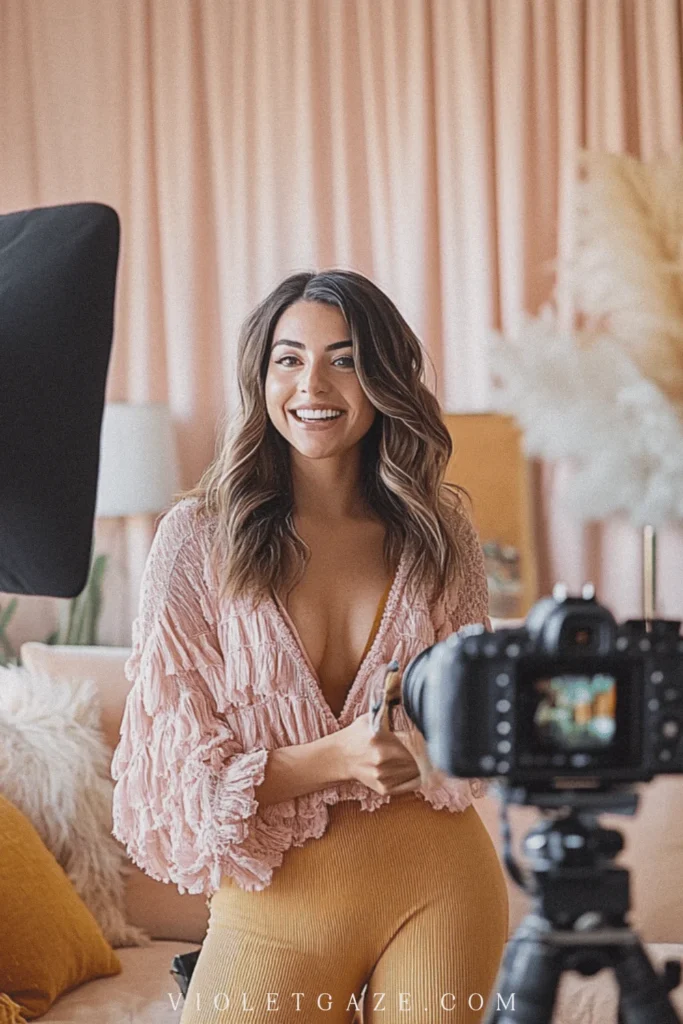I'm an artist at heart, performer and songwriter, and a lover of all things creatively & artistically beautiful. In this little corner of the internet, we talk about how to live an artistic lifestyle, fit with the tools, techniques, tips, and community. Get comfy and cozy.
BACK TO THE BLOG
Can we shatter the myth?: Creativity and strategy can work beautifully together.
To be fair, it took me a while to realize this. When I started my blog a year and a half ago, I thought that being thoughtful in my blog workflow would slow me down. And that being productive would speed it up, but take the care out of it.
There’s a delicate balance between the two, but the truth stands: you can be a thoughtful, intentional and productive blogger/artist.
All you need is a system in your blog workflow; a sort of conveyor belt, batching process that helps you spend less time on the tedious things (making Google Docs, copying templates) and more time on what matters, like writing a blog article that you are so dang proud of.


 Should Artists Get a Blog?
Should Artists Get a Blog?
But first, why am I even talking about blogging when it comes to our artist journey? Blogs have a lot of amazing qualities, especially for artists (if you want to go this route):

Maybe you finally opened that Etsy shop and want to tell people about it. Or you’ll be starring in a regional theatre production. Blogs are physically great ways to showcase these announcements on your website!

It’s funny how the internet works, but just by having a website and a blog and explaining what you do shows that you’re an authority in the field.


The way to make money through a blog is largely through affiliate marketing income, where you have special links throughout your article to certain products. When people click on these links, they’re meant to give you a small commission (since you were the one who brought traffic to this product).
Hey you! When you’re done with this, learn about the 3 Lifestyle Muses of being an artist and how you can use each to be a better artist.  |
 Key Elements of Your Joy-Sparking Blog Workflow
Key Elements of Your Joy-Sparking Blog Workflow
If you’ve decided that starting a blog is for you, no matter what reason, let’s make sure you’re set up with a blogging workflow that’s actually conducive to writing intentional blog posts.
I use the phrase joy-sparking directly from my favorite organizer, Marie Kondo. When your process feels intentional and caring, you’ll give that same intentionality and care back into your writing.
A “joy-sparking” workflow is one that energizes you, making the process of blogging as rewarding as the outcome. It’s about creating a system that aligns with your personality and artistic style, turning what could be a chore into the cherished ritual that is your blog workflow.
 Create a Beautiful Artistic System Via a “Content Assembly Line”
Create a Beautiful Artistic System Via a “Content Assembly Line”
Think of your blogging process as a content assembly line — a series of distinct stages that transform your raw ideas into polished blog posts.
I took Adam Enfroy’s blogging course and this was one of my favorite lessons! This approach basically brings structure to your creative process without stifling it.
Each stage of the assembly line focuses on a specific aspect of content creation, allowing you to channel your artistic energy more effectively.
Here’s an example of how I’ve structured my Content Assembly Line:
- Keyword research
- Finding secondary keywords
- Creating images
- Outlining the blog article
- Writing the blog article
- Editing the blog article
- Publishing
Breaking down the process into these stages, you can maintain consistency in your output while ensuring each piece receives the attention it deserves.
Plus, it then gives you the option to add the magic to it — through batching.


 Batch Batch Batch
Batch Batch Batch
When you make cookies, you don’t just put one into the oven, bake it, take it out, then add the next one. You create a batch of them.
Batching maximizes your time and helps you put out content at double (and sometimes even triple) the speed while alleviating the mental load of many annoying, repetitive tasks. It’s all about grouping similar tasks together and tackling them in dedicated blocks of time.
For instance, instead of:
Doing keyword research for blog → outlining blog → writing blog → creating images → write blog → publishing blog → doing keyword research for blog → outlining blog (etc)
You’d batch each task for the month, for example:
Doing keyword research for all blogs for September → outline all blogs for September → create images for all blogs for September → write all blogs for month of September in 1-2 weekends
Rinse and repeat.
I use Asana as editorial calendar management to help me plan out all of this.
 Use Colors That Make You Happy
Use Colors That Make You Happy
Never underestimate the power of color in your blogging process! The colors you surround yourself with can significantly impact your mood and creativity. Incorporating your favorite colors into your blogging workspace and process can turn a mundane task into an inspiring creative session.
I just talked about this in one of my recent videos about how surrounding yourself with your favorite colors in your home will unlock more inspiration and creativity (and alleviate creative blocks).
I not only use my favorite colors on my blog, but in my content planning tools like Asana and my Google Docs. I use purple and pink highlights and colors and my favorite fonts to make the process so much more enjoyable and pretty for myself.
Because who says that systems have to be rigid and boring?!
 Step-by-Step Guide to My Blogging Workflow
Step-by-Step Guide to My Blogging Workflow
Here’s the blog post workflow I go through that I’ve tweaked throughout the year and a half I’ve been blogging to reduce decision fatigue and streamline my process with all the other content I create and the cozy girl job I have!
Want to become a better artist? You’ll love this next blog post.  |
 1. Mindful Keyword Research
1. Mindful Keyword Research
For a true SEO (Search Engine Optimized) blog post, you’ll need every blog post to rank for 1 main keyword. For example, this one ranks for “blog workflow.”
I use SEMRush, which is a little pricey, but you can use Keysearch as a more affordable alternative to do it while still focusing on SEO optimization for bloggers. Basically, you’ll want to find a keyword that shows up “green” in these tools, while having as much competition as possible.
(These tools are also great for analytics and performance tracking which can help you stay motivated to keep blogging.)
Those are the two things you’re looking for in keyword research –
Competition, or how hard it is to actually rank on the first page of Google for it
Traffic, or how many people are actually searching for it
Great keyword research is the foundation of a great blog workflow. Plus, it alleviates that one problem that I always used to have with blogging — what the heck do I write about?!
To learn more about keyword research, I definitely recommend watching this video on Adam Enfroy’s channel. I like his down-to-earth tone and really loved his blogging course!
Ideally, you’ll have primary keywords (the main keyword) which you’ll use 3-5x throughout the article, and secondary keywords, which you’ll use 1x throughout the article. That video should tell you more about it, as that’s a whole lesson on its own.
 2. Outlining and Structure
2. Outlining and Structure
I can’t believe that I just started outlining my blog posts this year. I used to go from keyword research straight to writing the article, just letting the outline happen.
No, ma’am. This is not the recommended route! Outlines are a great way to structure your article and give yourself the ability to plan it before writing it.
When writing a blog article, you’ll outline it through its headers. In each article, there’s always 1 H1, and then several H2s, and H3s throughout it.
Here’s an example of how this blog article is laid out:
- H1: My Blog Workflow for Productive, Artistic Content Creation
- H2:
Should Artists Get a Blog?
- H2:
Key Elements of Your Joy-Sparking Blog Workflow
- H3:
Create a Beautiful Artistic System Via a “Content Assembly Line”
- H3:
Batch Batch Batch
- H3:
Use Colors That Make You Happy
- H3:
- H2:
(and so on).
Do you see how there are headings, and then subheadings? This is how I’ll outline the blog article. Then, it makes it so much easier for me to actually write the article, since the flesh of it is already planned out.


 3. Writing
3. Writing
Now comes the heart of the process — writing. You have your outline ready, so now it’s about writing to fill it in. Having this outline makes it so much easier to then fill in the blanks!
Writing can sometimes seem like the most overwhelming part, so here are some tips for enhancing your writing productivity techniques:
- Set a timer for 1 hour and stop whenever it’s done. Don’t put pressure on yourself to try to get it all done in one day, especially if you’re just starting.
- Set a Pomodoro Timer for 25 minutes on, and 5 minutes off. Loop this for an hour or try to see how many rounds it takes you.
- Create a designated spot for your blog writing. Maybe it’s in a different room of your home. Maybe it’s at the library, or a super cute coffee shop.
You can reward yourself every time you write a blog post, or use this as a way to motivate yourself to write via habit-stacking I.e., “I only go to the cute coffee shop I love when I’m writing blog posts!”
| Love being productive? Read this next: Weird & Wonderful Tools for Creatives to Own (But Many Don’t!) |
 4. Adding Aesthetic Pictures
4. Adding Aesthetic Pictures
Every blog needs pictures! But if you’re like me, you don’t have a professional, full-time photographer on-hand to capture all the best moments that you need for your blog posts.
Original images are ideal, but if you need, there are cute stock photos on Canva. I also love using MidJourney for beautiful images!
No matter how you get your images, this is also part of the batching process. I create all my pictures for the month in one go, and it’s saved hours of work!
Of course, your images should be relevant to your blog post and optimized for SEO! Some tips for SEO-ifying your images:
- Convert them to .wepb format or compress them as .pngs
- Use alt text by using your primary and/or secondary keywords to name them


 5. Cross-Posting Using Planoly
5. Cross-Posting Using Planoly
Once your blog post is live, it’s time to streeeeetch that content far and wide.
I bet you spent a lot of time on that article, and when you’re ready for using other social media platforms, you should draw inspiration from that blog post.
I repurpose my blog posts as:
- Instagram reels scripts
- Quote cards/carousels
- YouTube videos
- Pinterest pins (I pin every single one of my blog images!)
And while repurposing is the strategic part of it, having an app to actually help you post to all these platforms is really helpful.
I’ve enjoyed Planoly as a social media scheduler! It’s definitely not without its annoying bugs, but I’ve found that most social media scheduling platforms are like this.
I don’t use Planoly specifically for blog posting (that’s not a possibility), but I do use it for:
- Scheduling Instagram posts
- Scheduling Pins
- Scheduling YouTube Shorts
This is one of many collaboration tools for blog teams that can also be used quite nicely as a team of 1, which I bet you are.
 Embrace an Imperfect, Ever-Growing Blog Process & Subscribe on YouTube
Embrace an Imperfect, Ever-Growing Blog Process & Subscribe on YouTube
Something I always say is that “Quantity keeps you going. Quality gets you good.” And when you’re first starting out with your blog, you’ll want to focus on quantity! So keep going. Seriously. I talk more about it in this video
Perfectionism can be a creativity killer, so starting your blog should mean just getting blog posts out. The great part is that you can always edit blog posts later to make them better.
If you want more in-depth guidance on starting and loving your creative journey as an artist, subscribe to my YouTube channel for tips on balancing productivity and creativity in your artistic blogging journey.
Paragraph
Paragraph
Creative lifestyle
Creative lifestyle
Creative lifestyle
Paragraph
Xo, Kira Violet
I'm an artist at heart, performer and songwriter, and a lover of all things creatively & artistically beautiful. In this little corner of the internet, we talk about how to live an artistic lifestyle, fit with the tools, techniques, tips, and community. Get comfy and cozy.
BACK TO THE BLOG
I'll pass you little notes full of my latest musings, tips & fav creative tools for being your best artist.






